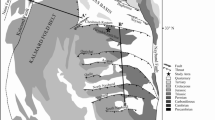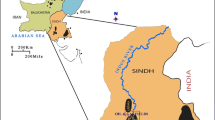Abstract
Since the appearance of trees in the Devonian, coal preservation in the geological rock record considerably increased and since then terrestrial coals are an extraordinary large sink for carbon in the geosphere. In Munindalen near Pyramiden (Dickson Land, Svalbard), low mature middle to upper Devonian strata (Mimerdalen Subgroup) crop out, which bear well recognizable terrestrial coal seams. Here, we report new geochemical and petrographical data of this ancient coal and compare them with younger coals of Svalbard from the Carboniferous, a period when land-dwelling plants started to rule the terrestrial realm. Similar to other Devonian cannel coals (highly bituminous terrestrial coals), the Munindalen coals are rich in spores and were most likely formed by early lycopsid trees in a near-equatorial setting. Geochemical data are in line with a predominantly liptinite-related origin of the coaly matter and the coals demonstrate a high hydrocarbon (oil) generation potential [hydrogen index: 570 mg hydrocarbons (HC)/g total organic carbon (TOC)]. Biomarkers support a terrestrial plant origin of the coals and demonstrate the geochemical simplicity of these very early terrestrial plants (e.g., by the lack of specific diterpanes known from modern plants and the occurrence of sterane-related simple pregnanes).

Georeferenced data from Norsk Polarinstitutt (http://data.npolar.no)





Similar content being viewed by others
References
Horn G (1928) Beiträge zur Kenntnis der Kohle von Svalbard. Skrifter om Svalbard og Ishavet, Det Kongelige Department, Oslo
Horn G (1941) Petrology of a Middle Devonian Cannel coal from Spitsbergen. Norske geol tidsskr 21:13–19
Vogt T (1941) Geology of a Middle Devonian Cannel coal from Spitsbergen. Norskr geol tidsskr 21:1–12
Berry CM, Marshall JEA (2015) Lycopsid forests in the early Late Devonian paleoequatorial zone of Svalbard. Geology 43:1043–1046
van Krevelen DW (1993) Coal-typology, physics, chemistry, constituents. Elsevier, Amsterdam
Vigran JO (1964) Spores from Devonian deposits, Mimerdalen, Spitsbergen. Norsk Polarinstitut Skrifter 132:1–32
Goodarzi F, Goodbody Q (1990) Nature and depositional environment of Devonian coals from western Melville island, Arctic Canada. Int J Coal Geol 14:175–196
Killops S, Killops V (2005) Introduction to organic geochemistry. Blackwell publishing, Oxford
Armstroff A, Wilkes H, Schwarzbauer J, Littke R, Horsfield B (2006) Aromatic hydrocarbon biomarkers in terrestrial organic matter of Devonian to Permian age. Palaeogeogr Palaeoclimatol Palaeoecol 240:253–274
Piepjohn K, Dallmann WK (2014) Stratigraphy of the uppermost Old Red Sandstone of Svalbard (Mimerdalen Subgroup). Pol Res 33:19998
Brinkmann L (1997) Geologie des östlichen zentralen Dickson Landes und Palynologie der Mimerdalen Formation (Devon), Spitzbergen. Diploma-Thesis. Westfälische Wilhelms-Universität Münster. In German
Michaelsen B, Piepjohn K, Brinkmann L (1997) Struktur und Entwicklung der svalbardischen Mimerelva Synkline im zentralen Dickson Land, Spitzbergen. Münster Forsch Geol Paläont 82:203–214
Schweitzer HJ (1999) Die Devonfloren Spitzbergens. (The Devonian flora of Spitsbergen). Schweizerbart Science Publishers, Stuttgart
Piepjohn K, Brinkmann L, Grewing A, Kerp H (2000) New data on the age of the uppermost ORS and the lowermost post-ORS strata in Dickson Land (Spitsbergen) and implications for the age of the Svalbardian deformation. In: Friend PF, Williams BPJ (eds) New perspectives on the Old Red Sandstone. Geological Society of London Special Publications, pp 603–609
Blumenberg M, Heunisch C, Lückge A, Scheeder G, Wiese F (2016) Photic zone euxinia in the central Rhaetian Sea prior the Triassic-Jurassic boundary. Palaeogeogr Palaeoclimatol Palaeoecol 461:55–64
ICCP (1998) The new vitrinite classification (ICCP System 1994). Fuel 77:349–358
ICCP (2001) The new inertinite classification (ICCP System 1994). Fuel 80:459–471
Pickel W, Kus J, Flores D, Kalaitzidis S, Christanis K, Cardott BJ, Misz-Kennan M, Rodrigues S, Hentschel A, Hamor-Vido M, Crosdale P, Wagner N (2017) Classification of liptinite—ICCP System 1994. Int J Coal Geol 169:40–61
Sýkorová I, Pickel W, Christanis K, Wolf M, Taylor GH, Flores D (2005) Classification of huminite—ICCP System 1994. Int J Coal Geol 62:85–106
Taylor G, Teichmüller M, Davis A, Diessel C, Littke R, Robert P (1998) Organic petrology. Gebrüder Borntraeger, Berlin
Abdullah WH, Murchison D, Jones JM, Telnaes N, Gjelberg J (1988) Lower Carboniferous coal depositional environments on Spitsbergen. Svalbard Org Geochem 13:953–964
van Koeverden JH, Karlsen DA, Schwark L, Chpitsglouz A, Backer-Owe K (2010) Oil-prone lower Carboniferous coals in the Norwegian Barents Sea: implications for a Palaeozoic petroleum system. J Petrol Geol 33:155–182
Petersen HI (2006) The petroleum generation potential and effective oil window of humic coals related to coal composition and age. Int J Coal Geol 67:221–248
Sykes R, Snowdon LR (2002) Guidelines for assessing the petroleum potential of coaly source rocks using Rock-Eval pyrolysis. Org Geochem 33:1441–1455
Peters-Kottig W, Strauss H, Kerp H (2006) The land plant δ13C record and plant evolution in the Late Palaeozoic. Palaeogeogr Palaeoclimatol Palaeoecol 240:237–252
Whiticar MJ (1996) Stable isotope geochemistry of coals, humic kerogens and related natural gases. Int J Coal Geol 32:191–215
Strauss H, Peters-Kottig W (2003) The Paleozoic to Mesozoic carbon cycle revisited: the carbon isotopic composition of terrestrial organic matter. Geochem Geophys Geosyst 4:1083
Didyk BM, Simoneit BRT, Brassell SC, Eglinton G (1978) Organic geochemical indicators of palaeoenvironmental conditions of sedimentation. Nature 272:216–222
ten Haven HL, De Leeuw JW, Rullkötter J, Sinninghe Damste JS (1987) Restricted utility of the pristane/phytane ratio as a palaeoenvironmental indicator. Nature 330:641–643
Bourbonniere RA, Meyers PA (1996) Sedimentary geolipid records of historical changes in the watersheds and productivities of Lakes Ontario and Erie. Limnol Oceanogr 41:352–359
Ourisson G, Rohmer M (1992) Hopanoids. 2. Biohopanoids: a novel class of bacterial lipids. Acc Chem Res 25:403–408
Armstroff A (2004) Geochemical Significance of Biomarkers in Paleozoic Coals, PhD-Thesis, RWTH Aachen University
Peters-Kottig W (2003) Untersuchungen zur Kohlenstoffisotopenzusammensetzung von terrestrischem organischen Material des jüngeren Paläozoikums. PhD-Thesis. University of Muenster, Münster
Huang W-Y, Meinschein WG (1979) Sterols as ecological indicators. Geochim Cosmochim Acta 43:739–745
Schulze T, Michaelis W (1990) Structure and origin of terpenoid hydrocarbons in some German coals. Org Geochem 16:1051–1058
Sheng G, Simoneit BRT, Leif RN, Chen X, Fu J (1992) Tetracyclic terpanes enriched in Devonian cuticle humic coals. Fuel 71:523–532
Alexander R, Kagi RI, Noble R, Volkman JK (1984) Identification of some bicyclic alkanes in petroleum. Org Geochem 6:63–70
Killops S, Stoddart D, Mills N (2014) Inferences for sources of oils from the Norwegian Barents Sea using statistical analysis of biomarkers. Org Geochem 76:157–166
Noble RA, Alexander R, Kagi RI, Knox J (1985) Tetracyclic diterpenoid hydrocarbons in some Australian coals, sediments and crude oils. Geochim Cosmochim Acta 49:2141–2147
Tewari A, Dutta S, Sarkar T (2017) Biomarker signatures of Permian Gondwana coals from India and their palaeobotanical significance. Palaeogeogr Palaeoclimatol Palaeoecol 468:414–426
Disnar JR, Harouna M (1994) Biological origin of tetracyclic diterpanes, n-alkanes and other biomarkers found in lower carboniferous Gondwana coals (Niger). Org Geochem 21:143–152
Kashirtsev VA, Moskvin VI, Fomin AN, Chalaya ON (2010) Terpanes and steranes in coals of different genetic types in Siberia. Russ Geol Geophys 51:404–411
Romero-Sarmiento M-F, Riboulleau A, Vecoli M, Laggoun-Défarge F, Versteegh GJM (2011) Aliphatic and aromatic biomarkers from Carboniferous coal deposits at Dunbar (East Lothian, Scotland): Palaeobotanical and palaeoenvironmental significance. Palaeogeogr Palaeoclimatol Palaeoecol 309:309–326
Norwegian Petroleum Directorate (2017) The North Barents Sea: geological assessment of petroleum resources in Eastern parts of Barents Sea North. Report. http://www.npd.no/en/Publications/Reports/Geological-assessment-of-petroleum-resources---Barents-Sea-north-2017/. Accessed 2 June 2017
Acknowledgements
We thank Malte Jochmann and Stein Henningsen for excellent cooperation during field work. Petra Adam, Monika Weiß and Sylvia Kramer are thanked for laboratory assistance. Samples were obtained during CASE 17-2, which was a geological expedition within the CASE research program (CASE = Circum Arctic Structural Events) of the German Federal Institute for Geosciences and Natural Resources (BGR).
Author information
Authors and Affiliations
Corresponding author
Additional information
This article was selected from the third Circum-Arctic Structural Event workshop which was held in Hannover (Germany) in March 2017.
Rights and permissions
About this article
Cite this article
Blumenberg, M., Weniger, P., Kus, J. et al. Geochemistry of a middle Devonian cannel coal (Munindalen) in comparison with Carboniferous coals from Svalbard. Arktos 4, 1–8 (2018). https://doi.org/10.1007/s41063-018-0038-y
Received:
Accepted:
Published:
Issue Date:
DOI: https://doi.org/10.1007/s41063-018-0038-y




